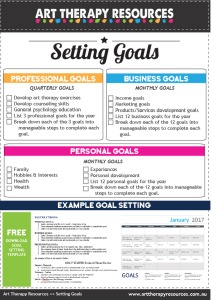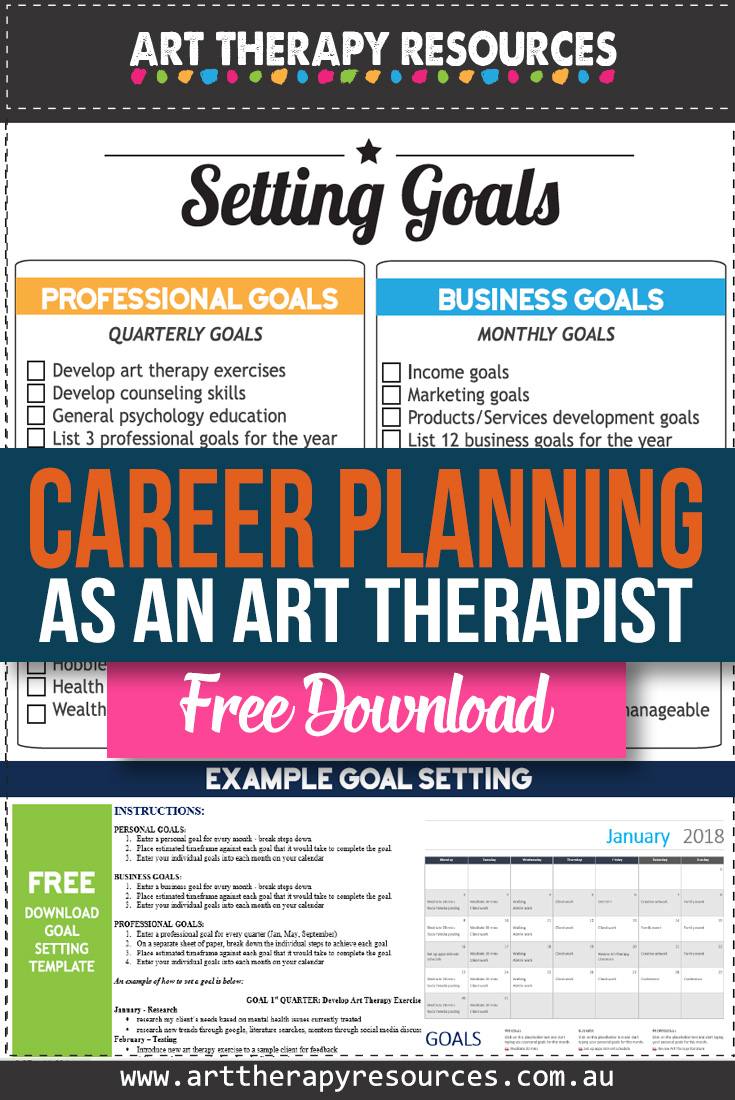THIS POST INCLUDES:
1. Professional art therapy experience
2. Identify further education
3. Therapist professional network
4. Art therapist short term goals
5. Art therapist long term goals
6. Free Download Goals Checklist + Goal Setting Calendar Template
PROFESSIONAL ART THERAPY EXPERIENCE
If you are working in your private practice, you will no doubt be spending a lot of time on administrative tasks as well as general tasks required to run your practice including marketing, managing, and legislative requirements.
While these tasks are important to developing and running your private practice, career planning can help you remain engaged in developing your professional career as an art therapist.
This blog helps identify some areas to think about when planning your career as an art therapist.
PAST EXPERIENCE
It’s useful to take some time to reflect on your past experiences as an art therapist. Think about the clients you worked with, the types of art therapy techniques you used, and the outcomes you achieved. Consider what you enjoyed most about your work and what you found challenging. This can help you identify your strengths and weaknesses as an art therapist.
Reflecting on your past experience as an art therapist can be a powerful tool in helping you develop your career plan. Here are some steps you can take to analyze your past experience:
1. Make a list of your past clients (no real names required) and the types of issues they were dealing with. Reflect on what techniques and interventions you used, what worked well, and what didn’t.
2. Think about the settings in which you have worked, such as hospitals, schools, or community centers. Consider what you enjoyed most about working in these settings, and what challenges you faced.
3. Consider the types of art therapy techniques you have used in the past. Reflect on which techniques you found most effective and which ones you would like to learn more about.
4. Identify any themes or patterns that emerge as you reflect on your past experience. For example, you may notice that you have a particular talent for working with children or that you enjoy working in group settings.
By analyzing your past experience in this way, you can gain a better understanding of your strengths and weaknesses as an art therapist and use this information to develop a clear career plan.
IDENTIFY FURTHER EDUCATION
Choosing further education can also be a difficult decision to undertake if you’re not entirely sure of the direction that you want to develop your art therapy career. In this situation, attending workshops, seminars, and conferences may help you to initially explore some potential areas of interest that you may have in furthering your education within art therapy, mental health, and psychology in general.
Here are some steps you can take to identify what further education you need to further your career as an art therapist:
Do you want to specialize in a particular area, such as working with a specific population or in a particular setting? Do you want to move into a leadership role or start your own practice? Knowing your goals can help you identify the education and training you need to achieve them.
Look at job postings for positions that align with your career goals. Review the education and training requirements for these positions to determine what qualifications you need to meet. This can also give you an idea of what skills and knowledge are in high demand in the field.
Reach out to colleagues and mentors in the field to get their perspectives on what education and training they found valuable in their career. They may be able to recommend specific programs or courses that can help you achieve your goals.
Many professional organizations offer resources on education and training opportunities for their members. Look at the art therapy association website for your country or other relevant professional organizations to see what resources they offer.
Advanced degrees or certifications can help you develop the skills and knowledge you need to advance your career. Look into graduate programs or certifications in art therapy or related fields, such as counseling or psychology.
Consider what areas you need to improve in your practice as an art therapist. This could include learning new techniques or theories, improving your understanding of a specific population, or developing business skills to start your own practice. Once you identify these gaps, you can look for education and training opportunities that address them.
By taking these steps, you can identify what further education and training you need to advance your career as an art therapist. Remember that continuing education is an important part of professional development and can help you stay up-to-date on developments in the field.
ART THERAPIST SHORT TERM GOALS
The two primary methods to help define your short term goals:
1. Identify what you need to learn in your career to help bridge the gap on areas of art therapy that you need to learn in the immediate future to help your clients now.
2. Identify your long term goals and once they are defined, use those goals to create short term goals where you can being to training where necessary.
When setting your short-term goals, make sure they are SMART: specific, measurable, achievable, relevant, and time-bound. For example, instead of setting a goal to “improve my skills,” set a goal to “attend a workshop on mindfulness techniques for art therapy within the next three months.
Determine which goals are most important to achieving your long-term career goals and prioritize them accordingly. This can help you focus your time and energy on the most critical tasks.
Once you have identified your short-term goals, create an action plan to achieve them. This may include identifying the steps you need to take, such as registering for a workshop or applying for a certification program, and setting deadlines for each step.
Regularly review your short-term goals to track your progress and make adjustments as needed. This can help you stay on track and make the most of your time and resources.
By setting short-term goals that are specific, achievable, and relevant to your long-term career goals, you can develop your career as an art therapist and take concrete steps toward achieving your professional aspirations.
ART THERAPIST LONG TERM GOALS
Start by visualizing your ideal future as an art therapist. What kind of work do you want to do? Where do you see yourself working? What kind of impact do you want to have on your clients and the field of art therapy?
Once you have a clear picture of your ideal future, break it down into smaller, achievable goals. These could include things like earning a certification or advanced degree, building a network of professional contacts, or gaining experience in a particular area of art therapy.
Like with short-term goals, it’s important to make your long-term goals SMART: specific, measurable, achievable, relevant, and time-bound. For example, instead of setting a goal to “become a successful art therapist,” set a goal to “build a private practice with 20 regular clients within the next five years.
Consider what challenges you may face as you work toward your long-term goals, such as financial constraints or lack of resources. Then, develop a plan to overcome these obstacles. This may involve seeking out funding or scholarships, building a support network of colleagues and mentors, or developing a side hustle to supplement your income.
Review your long-term goals regularly to track your progress and adjust your plans as needed. As your career develops, your goals may shift or change altogether, so it’s important to remain flexible and open to new opportunities.
By setting long-term goals that are specific, achievable, and relevant to your vision for your future as an art therapist, you can develop a clear path for your career and take meaningful steps toward achieving your professional aspirations.
FREE DOWNLOAD: Goal setting

BUILD YOUR ART THERAPY REFERENCE MATERIALS:
Pin this image to your Pinterest board.

SHARE KNOWLEDGE & PASS IT ON:
If you’ve enjoyed this post, please share it on Facebook, Twitter, Pinterest. Thank you!
